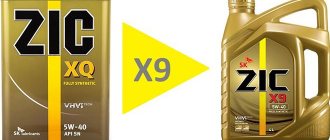There is an expression: a car loves affection and care. And this is partly true, so you should monitor the condition of the iron horse very carefully. The same principle should be used when choosing motor oil. These products are produced in large quantities, and the wide range can confuse any car owner, regardless of his experience. One of the frequently asked questions is: which motor oil is better to use - synthetic or semi-synthetic? And what is the difference between them?
Main characteristics of “synthetics”
Synthetic oil, as you might guess from the name, is an artificially created liquid through chemical synthesis and processing of petroleum products.
The properties of the composition remain virtually unchanged even after long-term use. Synthetic is one of the best oils, which is characterized by immunity to oxidation. The improved molecular formula is also one of the advantages of the substance. The performance of the car is also improved by the set of additives contained in these products initially - they increase compression in the cylinders. Due to this, fuel combustion improves and the power of the internal combustion engine increases.
Another positive characteristic of such a substance is its viscosity. It also does not change density with temperature changes. Starting a car is much easier with this composition than with a mineral or semi-synthetic one.
At the same time, this product has one significant drawback - high cost. Therefore, it is more economical to use it on foreign cars than on Zhiguli cars.
Synthetic engine oil and its characteristics
All of the above problems with natural mineral oil were solved with the help of a synthetically produced product. The production of pure synthetic oil is based on the synthesis of molecules, therefore, not related to nature, it gives more stable performance in operating mode. Synthetics are not afraid of temperature changes or aggressive environments, maintaining their properties all year round thanks to additives. Again, the synthetic base is very important; it determines how well this or that additive will perform.
Pros of synthetic oils:
- maintaining viscosity when temperature changes;
- good fluidity in cold conditions;
- practically do not evaporate;
- have excellent anti-friction properties;
- stable;
- can make do with a minimum of additives, since the main characteristics are obtained during industrial synthesis.
Main characteristics of “semi-synthetics”
Semi-synthetic motor oil includes both mineral and synthetic, being, in fact, a mixture. Moreover, the percentage of content of both is not regulated in any way, and these characteristics may be different for different manufacturers. Most often, the percentage of mineral motor oil is about 50. Semi-synthetics are significantly inferior to the oil described above in such important characteristics as viscosity and degree of oxidation. This substance also has a low level of additives. Semi-synthetics will not allow you to quickly start a car in cold winter weather due to their low viscosity level, but their cost is significantly lower than that of synthetic oils. Therefore, it is better to use it in budget cars.
So, the difference between the two substances described above is as follows:
- The synthetic composition is distinguished by a better set of additives, resistance to oxidation reactions, as well as viscosity, which allows you to start the car quickly enough even in winter;
- The semi-synthetic composition has a low price, which makes this substance more accessible (about 200 rubles - half the price of a synthetic one);
- The first substance is best used in imported cars.
Advantages and disadvantages of semi-synthetics
Semi-synthetic oil is a mixture of two types of motor oils: synthetic and mineral. This combination made it possible to obtain an optimal, average option between full synthetics and natural oil. This step was taken forcedly, since it turned out that synthetics, which have a set of many excellent qualities, including resistance to oxidative processes and outstanding protective washing properties, are not suitable for all brands of cars. In turn, “mineral water” is in no way suitable for trips with high loads at low temperatures.
Therefore, “semi-synthetics” made it possible to improve the characteristics of “mineral water” and strengthen its resistance to oxidation. The resulting product is an excellent protection of the motor from such undesirable phenomena as wear. What is important is that semi-synthetics do not lose their original qualities for a very long time, allowing them to be used for a very long time. Another definite “advantage” of this oil is that it can be successfully used for almost any car. Here is just one of many typical examples. If the engine previously had mineral water, it is not recommended to fill it with synthetics after it, since this can increase engine wear. But semi-synthetics as a successor to mineral water will do without question. It also has the ability to resist low and high temperatures, which allows it to be widely used in cold and hot weather; it is more resistant than mineral water. It is also important that semi-synthetics are cheaper than synthetics, which also contributes to its wide popularity and demand.
Which oil should you choose?
Synthetic compounds have characteristics that perform well in operation - chemical and thermal stability. In this regard, engine overheating can be avoided.
In addition, due to the viscosity and fluidity of the substance, there are no problems with temperature changes, which allows the car to withstand heavy loads.
Semi-synthetic compositions look preferable to “mineral water” and have their own characteristics. For example, this substance is best used in cars whose mileage is less than ten thousand kilometers. In other indicators they are inferior to their expensive counterpart.
The best engine flushing oils
How and how to remove machine oil from clothes
The modern market in this niche offers traditional mineral-based oils, as well as long-term and five-minute washes.
The latter are ineffective and do more harm than help. Therefore, the search range is narrowed to mineral water and high-quality fills.
Liqui Moly Oil-Schlamm-Spulung – flushing additive
4.9
★★★★★ editorial assessment
90% of buyers recommend this product
The long-lasting washing liquid contains heat-stable dispersants and slightly soluble detergents. They effectively remove oil layers, sludge and dark sediment from the crankcase and circuit.
The product is universal and suitable for cleaning engines of any design. And yet it is not a lubricant in the full sense.
Oil-Schlamm is added to the engine oil shortly before its scheduled change. As a result of such flushing, fuel consumption is reduced, the knocking of hydraulic compensators and noise in the chain drive are eliminated. The power of a cleaned motor increases, and starting it no longer causes problems.
Advantages:
- compact packaging;
- soft, layer-by-layer cleaning;
- safe for sealants;
- forms a protective layer that prevents wear of the mechanism;
- maximum removal of contaminants and used oil;
- easily removed from the system.
Flaws:
the price is above average.
Oil-Schlamm-Spulung is recommended for high-mileage internal combustion engines with high wear. It is better to fill it in the last 200 km before changing the oil.
ZIC Flush Synthetic – flushing with protection
4.6
★★★★★ editorial assessment
86% of buyers recommend this product
An effective flushing agent suitable for cleaning not only internal combustion engines, but also manual transmissions. The liquid is poured into the engine instead of used oil and used as a lubricant for some time.
The product is made on the basis of Yubase synthetics with a high content of hydrocracking. And the package of detergent additives in its composition (detergents and dispersants) effectively dissolves plaque and sludge deposits.
Advantages:
- prevents oxidation of new motor oil;
- eliminates noise in the engine and transmission;
- increases the efficiency and efficiency of internal combustion engines;
- does not dry out rubber and polymer fillers;
- Effectively dissolves sludge and oil film.
Flaws:
- high retail cost;
- you come across counterfeit products that are difficult to distinguish from original products.
It is recommended to use before switching to ZIC brand engine oil.
Is it possible to put semi-synthetic into the engine with synthetics?
These substances have a different set of additives, and mixing them can lead to consequences that are very difficult to determine in advance. Therefore, it is better not to conduct such experiments with the engine of your car. If you do mix oils, you should use products from the same manufacturer (the whole point is that one company’s product production technology differs from that of another company, which is much more important than the viscosity characteristics). This approach will avoid premature wear of the engine and its parts.
Features of switching from one type of oil to another
Older engines were developed during a time when viscous mineral fluid was widely used. The engine parts of old cars are located with fairly large gaps. Liquid synthetics poured into them penetrate into these gaps, which can cause damage to the system. Therefore, for older cars, switching from mineral water to synthetic material is impractical. But it is possible to switch from semi-synthetics to synthetics, but this must be done in compliance with certain rules.
When replacing one oil model with another, it is imperative to flush the engine. This is due to the fact that even after draining, sediment remains on the walls. Because of this, when a new type of petroleum product is poured into the engine compartment, undesirable chemical reactions may occur caused by a different additive package, which will lead to engine damage.
Conclusion
When choosing between synthetic and semi-synthetic oils, you need to be guided by the following information about the car:
- Country of origin;
- Service life;
- Running;
- It is also important what kind of oil was used before.
How to choose motor oil?
For a completely new car, regardless of the country of manufacture, semi-synthetics are perfect. After the car has covered about fifteen thousand kilometers, it is better to use synthetics - this will increase the service life of the engine due to the fact that it is thicker. As a result, we can conclude that the difference between these substances is not very large.
What happens if you mix synthetics with semi-synthetics?
There is a lively debate among car enthusiasts when it comes to whether it is possible to mix synthetics and semi-synthetics. Opinions on this matter are completely different. Some believe that such mixing is completely acceptable and will not affect the operation of the engine in any way, so they recommend safely pouring a combined mixture of motor oils into the engine. Objecting or opponents of such a transformation of two fundamentally different types of oils consider it absolutely unacceptable, they give critical arguments and examples of what will happen if a mixture of synthetics and semi-synthetics is deliberately added to the engine.
As often happens in life, the truth in a dispute lies somewhere in the middle. If you ask an expert whether it is possible to mix synthetics with semi-synthetics without negative consequences, he will give a positive answer, but with the obligatory consideration of a number of those essential points, which have already been partially described above.
And yet, as a conclusion, it is necessary to warn against the obsessive desire to experiment with these two types of oils. Agree that if mixing them for any car were completely acceptable for any car, it would have long ago become widespread practice both in our country and abroad. However, this is not the case yet, so there is no need to risk your car engine by pouring a mixture of oils into it at every opportunity. This is fraught with considerable troubles with the car, which will entail significant financial and time expenses, as well as worries.
The best prices and conditions for the purchase of new cars
Credit 9.9% / Installments / Trade-in / 98% approval / Gifts in the salon
Mas Motors
November 30, 2017
The widest range of automotive lubricants available for sale is divided into 3 groups: mineral, synthetic and semi-synthetic origin. When purchasing “consumables” for servicing a car, car enthusiasts often think about the question of which oil is better for the engine – “synthetic” or “semi-synthetic”. Both products are good, but the price difference is significant. The problem should be considered from different angles.











